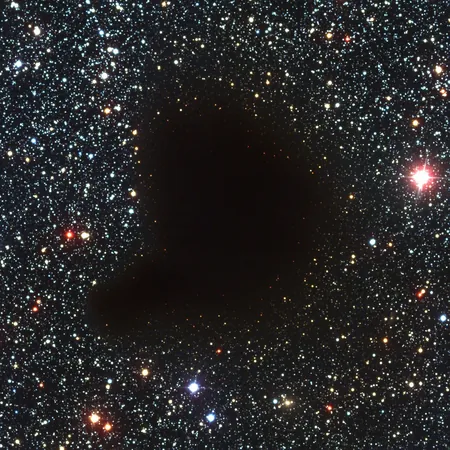
Unlocking the Mysteries of Star Formation: Tracking Molecules in the Interstellar Medium
2025-07-14
Author: Emily
The Challenge of Tracking Star-Forming Materials
Stars don’t just appear out of nowhere; they form from the gas and dust floating across the galaxy. However, tracking these ethereal materials is no easy feat. These particles hang in the vacuum of space at nearly absolute zero, emitting very little light and creating a conundrum for astronomers trying to study them. Interestingly, the very secret of their elusive nature may provide the solution: their absorption lines—the unique signatures of the materials the light passes through on its journey to Earth.
A Groundbreaking Study on the Interstellar Medium
A recent study by Harvey Liszt of the National Radio Astronomy Observatory and Maryvonne Gerin from Sorbonne University reveals a groundbreaking method for tracing this so-called "dark neutral medium" of interstellar gas throughout our galaxy. Published on the arXiv preprint server, the research examines 88 sight lines—essentially direct paths from Earth to exceptionally bright celestial objects, such as quasars or other distant galaxies. As these brilliant light sources send their rays towards Earth, some of that light gets absorbed by the interstellar medium (ISM), creating a distinctive dark mark in the observed spectra.
Harnessing Radio Waves to Understand the Universe
The study turns the spotlight on radio astronomy, focusing on data from impressive facilities like the Atacama Large Millimeter/Submillimeter Array (ALMA) and the Institut de radioastronomie millimétrique at Sorbonne. Even contributions from the Arizona Radio Observatory play a role, pooling data collected over nearly three decades.
Key Molecules Unveiled in the ISM
Highlighting six different ions, the researchers found notable success with formyl cation (HCO+), which appeared in 72 of the 86 examined sight lines. This molecule emerges as a reliable predictor of molecular hydrogen gas (H2), the universe's most abundant yet notoriously elusive molecule. When HCO+ is abundant, there's a strong likelihood that substantial amounts of H2 are present, indicating potential areas of future star formation.
Another significant molecule, Hydrogen Cyanide (HCN), surprised astronomers by existing beyond the dense star-forming regions previously thought to harbor it in abundance. This finding calls for a re-evaluation of how HCN forms throughout the ISM.
The second-most plentiful molecule discovered, the ethynyl radical (C2H), serves as a clue to how straightforward hydrocarbons interact and develop into more complex structures. The study reveals that the ratio of C2H to HCO+ fluctuates based on local environmental conditions like dust presence, offering tantalizing insights into ongoing cosmic processes.
Not All Molecules Are Created Equal
However, not every molecule proved easy to track. Carbon monosulfide (CS) was notably absent, while carbon monoxide (CO) was only spotted alongside HCO+, making it somewhat redundant despite being significantly brighter than HCO+. Regular formyl radicals (HCO) were widespread throughout space but difficult to detect, relegating them to a lesser role compared to their more distinguishable counterpart, HCO+.
Mapping the Cosmos for Future Star Births
Ultimately, tracing these gases across the galaxy effectively maps potential star formation zones, illuminating how the ISM begins to conglomerate in preparation for new celestial births. As more advanced telescopes come online, the signals from these molecules will grow clearer, allowing us to better understand this obscured aspect of our universe—one teeming with the raw materials for the next generation of stars.









 Brasil (PT)
Brasil (PT)
 Canada (EN)
Canada (EN)
 Chile (ES)
Chile (ES)
 Česko (CS)
Česko (CS)
 대한민국 (KO)
대한민국 (KO)
 España (ES)
España (ES)
 France (FR)
France (FR)
 Hong Kong (EN)
Hong Kong (EN)
 Italia (IT)
Italia (IT)
 日本 (JA)
日本 (JA)
 Magyarország (HU)
Magyarország (HU)
 Norge (NO)
Norge (NO)
 Polska (PL)
Polska (PL)
 Schweiz (DE)
Schweiz (DE)
 Singapore (EN)
Singapore (EN)
 Sverige (SV)
Sverige (SV)
 Suomi (FI)
Suomi (FI)
 Türkiye (TR)
Türkiye (TR)
 الإمارات العربية المتحدة (AR)
الإمارات العربية المتحدة (AR)